Related Research Articles
Nitrogen fixation is a chemical process by which molecular nitrogen (N
2), with a strong triple covalent bond, in the air is converted into ammonia (NH
3) or related nitrogenous compounds, typically in soil or aquatic systems but also in industry. Atmospheric nitrogen is molecular dinitrogen, a relatively nonreactive molecule that is metabolically useless to all but a few microorganisms. Biological nitrogen fixation or diazotrophy is an important microbially mediated process that converts dinitrogen (N2) gas to ammonia (NH3) using the nitrogenase protein complex (Nif).
Diazotrophs are bacteria and archaea that fix atmospheric nitrogen gas into a more usable form such as ammonia.
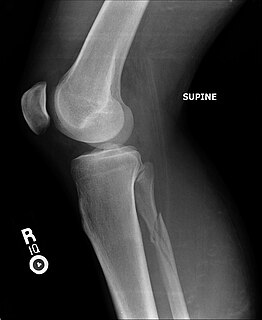
The Maisonneuve fracture is a spiral fracture of the proximal third of the fibula associated with a tear of the distal tibiofibular syndesmosis and the interosseous membrane. There is an associated fracture of the medial malleolus or rupture of the deep deltoid ligament of the ankle. This type of injury can be difficult to detect.

A distal radius fracture, also known as wrist fracture, is a break of the part of the radius bone which is close to the wrist. Symptoms include pain, bruising, and rapid-onset swelling. The wrist may be broken for life. The ulna bone may also be broken.
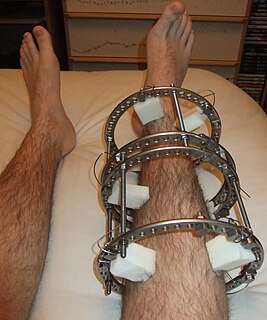
External fixation is a surgical treatment wherein rods are screwed into bone and exit the body to be attached to a stabilizing structure on the outside of the body. It is an alternative to internal fixation, where the components used to provide stability are positioned entirely within the patient's body. It is used to stabilize bone and soft tissues at a distance from the operative or injury focus. They provide unobstructed access to the relevant skeletal and soft tissue structures for their initial assessment and also for secondary interventions needed to restore bony continuity and a functional soft tissue cover.

A symphysis is a fibrocartilaginous fusion between two bones. It is a type of cartilaginous joint, specifically a secondary cartilaginous joint.
- A symphysis is an amphiarthrosis, a slightly movable joint.
- A growing together of parts or structures.

The Ilizarov apparatus is a type of external fixation used in orthopedic surgery to lengthen or reshape limb bones; as a limb-sparing technique to treat complex and/or open bone fractures; and in cases of infected nonunions of bones that are not amenable with other techniques. It is named after the orthopedic surgeon Gavriil Abramovich Ilizarov from the Soviet Union, who pioneered the technique.
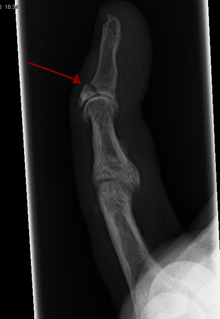
An avulsion fracture is a bone fracture which occurs when a fragment of bone tears away from the main mass of bone as a result of physical trauma. This can occur at the ligament by the application of forces external to the body or at the tendon by a muscular contraction that is stronger than the forces holding the bone together. Generally muscular avulsion is prevented by the neurological limitations placed on muscle contractions. Highly trained athletes can overcome this neurological inhibition of strength and produce a much greater force output capable of breaking or avulsing a bone.
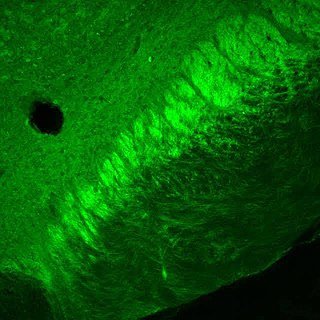
In the fields of histology, pathology, and cell biology, fixation is the preservation of biological tissues from decay due to autolysis or putrefaction. It terminates any ongoing biochemical reactions and may also increase the treated tissues' mechanical strength or stability. Tissue fixation is a critical step in the preparation of histological sections, its broad objective being to preserve cells and tissue components and to do this in such a way as to allow for the preparation of thin, stained sections. This allows the investigation of the tissues' structure, which is determined by the shapes and sizes of such macromolecules as proteins and nucleic acids.
Regression, according to psychoanalyst Sigmund Freud, is a defense mechanism leading to the temporary or long-term reversion of the ego to an earlier stage of development rather than handling unacceptable impulses more adaptively. In psychoanalytic theory, regression occurs when an individual's personality reverts to an earlier stage of development, adopting more childish mannerisms.

Cubitus varus is a varus deformity in which the extended forearm is deviated towards midline of the body.

An open fracture, also called a compound fracture, is a type of bone fracture in orthopedics that is frequently caused by high energy trauma. It is a bone fracture associated with a break in the skin continuity which can cause complications such as infection, malunion, and nonunion. Gustilo open fracture classification is the most commonly used method to classify open fractures, to guide treatment and to predict clinical outcomes. Advanced trauma life support is the first line of action in dealing with open fractures and to rule out other life-threatening condition in cases of trauma. Cephalosporins are generally the first line of antibiotics. The antibiotics are continued for 24 hours to minimize the risk of infections. Therapeutic irrigation, wound debridement, early wound closure and bone fixation are the main management of open fractures. All these actions aimed to reduce the risk of infections.
Fixation is a concept that was originated by Sigmund Freud (1905) to denote the persistence of anachronistic sexual traits. The term subsequently came to denote object relationships with attachments to people or things in general persisting from childhood into adult life.

The Taylor Spatial Frame (TSF) is an external fixator used by paediatric and orthopaedic surgeons to treat complex fractures and bone deformities. The medical device shares a number of components and features of the Ilizarov apparatus. The Taylor Spatial Frame is a hexapod device based on a Stewart platform, and was invented by orthopaedic surgeon Charles Taylor. The device consists of two or more aluminum or carbon fibre rings connected by six struts. Each strut can be independently lengthened or shortened to achieve the desired result, e.g. compression at the fracture site, lengthening, etc. Connected to a bone by tensioned wires or half pins, the attached bone can be manipulated in three dimensions and 9 degrees of freedom. Angular, translational, rotational, and length deformities can all be corrected simultaneously with the TSF.
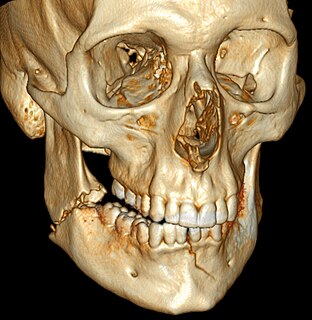
Mandibular fracture, also known as fracture of the jaw, is a break through the mandibular bone. In about 60% of cases the break occurs in two places. It may result in a decreased ability to fully open the mouth. Often the teeth will not feel properly aligned or there may be bleeding of the gums. Mandibular fractures occur most commonly among males in their 30s.
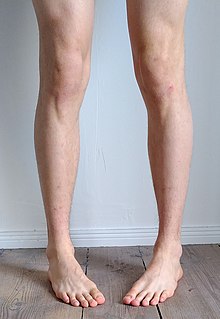
Pigeon toe, also known as in-toeing, is a condition which causes the toes to point inward when walking. It is most common in infants and children under two years of age and, when not the result of simple muscle weakness, normally arises from underlying conditions, such as a twisted shin bone or an excessive anteversion resulting in the twisting of the thigh bone when the front part of a person's foot is turned in.
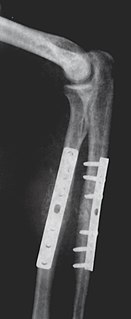
Internal fixation is an operation in orthopedics that involves the surgical implementation of implants for the purpose of repairing a bone, a concept that dates to the mid-nineteenth century and was made applicable for routine treatment in the mid-twentieth century. An internal fixator may be made of stainless steel, titanium alloy, or cobalt-chrome alloy. or plastics.
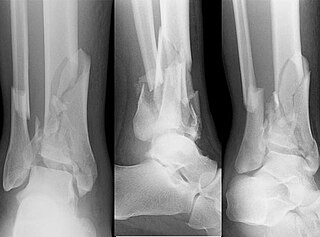
A pilon fracture, is a fracture of the distal part of the tibia, involving its articular surface at the ankle joint. Pilon fractures are caused by rotational or axial forces, mostly as a result of falls from a height or motor vehicle accidents. Pilon fractures are rare, comprising 3 to 10 percent of all fractures of the tibia and 1 percent of all lower extremity fractures, but they involve a large part of the weight-bearing surface of the tibia in the ankle joint. Because of this, they may be difficult to fixate and are historically associated with high rates of complications and poor outcome.
Early appropriate care (EAC) is a system in orthopaedic trauma surgery aiming to identify serious major trauma patients and treat the most time-critical injuries without adding to their physiological burden.
References
- ↑ "Internal Fixation for Fractures - OrthoInfo - AAOS". www.orthoinfo.org. Retrieved 29 January 2022.